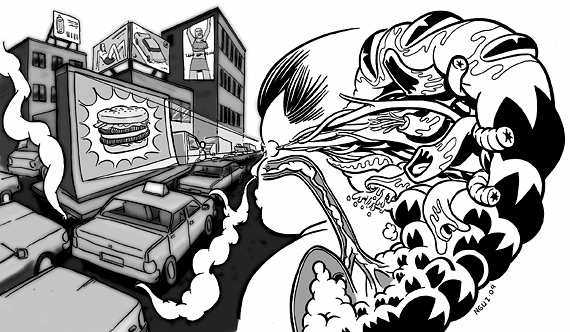by Nick Anapliotis : : : : : : : It’s another air quality advisory day in Toronto. Making your way along the sidewalk you hear hundreds of vehicles idling in rush hour traffic. The cars crawl forward a few metres, and a truck comes in to view. It carries a huge billboard, advertising a perfume, then flips to another panel promoting a high-end strip club. Welcome to the phenomenon of mobile billboards — large truck-mounted ads driven solely for the purpose of advertising. Despite being a none-too-subtle medium, it seems to have slipped through the cracks and loopholes of advertising regulations to become a fixture on streets across Canada, including Toronto’s gridlocked avenues. By-laws exist limiting the size of billboards and what type of advertising is suitable for a neighbourhood, but mobile billboards drive a hole right through such regulations. They go where they want to. Have a product that you want to push to the up-market set? Cruise on over to Yorkville. Got some new beverage that you want the club kids to be drinking while they’re out on the town? Head over to the club district. This sort of intrusiveness, as well as the associated negative environmental effects, has turned many people against mobile billboards. In Montreal, where more than 30 ad trucks roam the streets, various campaigns have tried to halt or limit their use. In 2002 a group calling themselves “les decorateurs” began a direct-action campaign, attacking ad trucks with paint bombs and throwing spiked boards under the trucks’ tires. In June of 2003 the environmental group l’Association quebecoise de lutte contre la pollution atmospherique (AQLPA) started collecting thousands of signatures urging the City of Montreal to enforce its ban on ad trucks. According to the group’s figures, ad trucks operating in Montreal travel more than 2.3 million kilometres each year, and contribute harmful amounts of carbon dioxide into the atmosphere. Despite existing by-laws prohibiting the use of mobile billboard trucks, the city has not taken any action, fearing any prohibition would not withstand a court challenge by the advertising companies. While activists voice their complaints against mobile billboards, the companies who are responsible for them try to put a positive spin on their trade. Motomedia has a fleet of ten trucks nationwide and keeps four in the Toronto area. Trucks operating in the GTA are run on a fuel substitute called biodiesel which helps reduce emissions. Peter Kosyk, the Executive Director of Wild on Wheels (a newcomer to the mobile market), told Spacing that when his company selected its vehicles they wanted them to be “unobtrusive.” In Vancouver, the city has taken action. In November 2002, city engineering staff observed Motomedia trucks operating on Vancouver’s streets and informed the company that they were violating a city by-law which requires firms like Motomedia to first seek permission from city council. The company was ordered to halt operations until council could decide on the matter. On July 31, 2003, Vancouver denied Motomedia permission to operate in the city. In an administrative report, the General Manager of Engineering Services recommended that council deny permission to the company due to its harmful environmental effects and its visual pollution, referring to the trucks as “an unwelcome intrusion into the public realm.” And what about Toronto? Mobile billboard companies seem to be operating in a huge grey zone. Permits and licenses are not required and city sign regulations don’t seem to apply. And even if they did, the amalgamation of the six former cities’ relevant by-laws is still slogging its way through Toronto’s bureaucracy. |
|
spacing.ca || contact || subscribe || in this issue || stores (c) 2005 Spacing Publishing |

